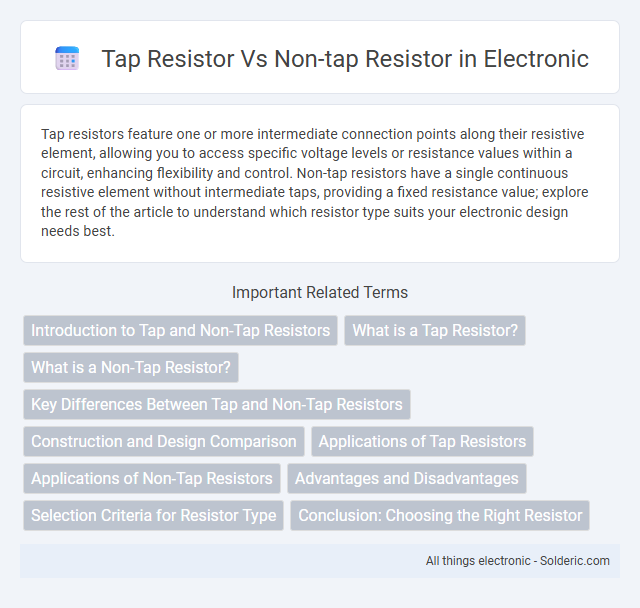Tap resistors feature one or more intermediate connection points along their resistive element, allowing you to access specific voltage levels or resistance values within a circuit, enhancing flexibility and control. Non-tap resistors have a single continuous resistive element without intermediate taps, providing a fixed resistance value; explore the rest of the article to understand which resistor type suits your electronic design needs best.
Comparison Table
| Feature | Tap Resistor | Non-Tap Resistor |
|---|---|---|
| Definition | Resistor with intermediate connections (taps) to access variable resistance points | Fixed resistor without intermediate terminals |
| Resistance Adjustment | Allows variable resistance selection via taps | Fixed resistance value |
| Applications | Voltage dividers, tuning circuits, adjustable filters | Current limiting, fixed voltage drops, biasing circuits |
| Complexity | More complex due to multiple contact points | Simple construction |
| Cost | Generally higher cost | Lower cost |
| Reliability | Potentially less reliable because of multiple connections | Higher reliability with fewer failure points |
Introduction to Tap and Non-Tap Resistors
Tap resistors feature one or more intermediate connection points along their resistive element, allowing adjustable resistance levels within a single component. Non-tap resistors provide a fixed resistance value without intermediate taps, offering straightforward, stable resistance for standard circuit applications. Tap resistors enable finer control in voltage division and signal tuning, whereas non-tap resistors are favored for simplicity and reliability in fixed-resistance roles.
What is a Tap Resistor?
A tap resistor features a middle connection point, or "tap," allowing it to provide variable voltage outputs within a circuit, unlike a non-tap resistor which has only two terminals and a fixed resistance. This design enables precise voltage division and improved control over current flow, essential in applications like audio equipment and voltage regulators. Your choice between tap and non-tap resistors depends on the need for adjustable resistance or fixed resistance in the electrical design.
What is a Non-Tap Resistor?
A non-tap resistor is a fixed-value resistor that does not have any intermediate connection points along its length, providing a consistent resistance across its entire component. Unlike tap resistors, which include adjustable taps to vary the output voltage or current, non-tap resistors offer a stable, unchanging resistance ideal for precision circuits requiring steady electrical conditions. Your choice between these depends on whether circuit adjustability or fixed resistance is needed for accurate performance.
Key Differences Between Tap and Non-Tap Resistors
Tap resistors feature one or more intermediate connection points along their resistive element, allowing for adjustable voltage or current levels, while non-tap resistors provide a fixed resistance without any intermediate connections. Tap resistors are commonly used in applications like voltage dividers and adjustable circuits, offering flexibility in tuning, whereas non-tap resistors are preferred for stable, consistent resistance values in standard electrical circuits. Understanding the presence or absence of these tap points is crucial for selecting the right resistor based on your design requirements.
Construction and Design Comparison
Tap resistors feature multiple intermediate connection points along their resistive element, allowing adjustable resistance values by selecting different taps, which enhances flexibility in circuit design. Non-tap resistors, also known as fixed resistors, consist of a single continuous resistive element without intermediate taps, resulting in a fixed resistance value determined by the material and geometry. The construction of tap resistors involves more complex layering and precise contact points, whereas non-tap resistors have a simpler, uniform structure optimized for stability and reliability.
Applications of Tap Resistors
Tap resistors are widely used in voltage regulation and precise adjustment applications due to their ability to provide multiple voltage output levels through intermediate connection points. They are essential in audio equipment for volume control, power supplies for fine-tuning voltage, and sensor circuits requiring variable resistance settings. Non-tap resistors are typically employed where fixed resistance is needed without variability, such as in basic current limiting and biasing circuits.
Applications of Non-Tap Resistors
Non-tap resistors are widely used in electronic circuits where fixed resistance values are essential for stable performance, such as in voltage dividers, current limiting, and biasing applications. These resistors provide reliable and uniform resistance without the need for adjustment, making them ideal for consumer electronics, power supplies, and signal processing devices. Their straightforward design simplifies circuit complexity and enhances durability in environments requiring consistent resistance throughout operation.
Advantages and Disadvantages
Tap resistors offer precise voltage division and improved circuit control by providing multiple connection points along the resistive element, enabling customizable resistance settings. Non-tap resistors are simpler, more cost-effective, and typically have higher reliability in fixed-resistance applications but lack the versatility of adjustable configurations. The main disadvantage of tap resistors is increased complexity and potential contact resistance issues, while non-tap resistors cannot accommodate variable resistance needs without additional components.
Selection Criteria for Resistor Type
Selection criteria for tap resistors versus non-tap resistors primarily depend on the need for voltage adjustment and customization in circuits. Tap resistors allow multiple voltage outputs through intermediate connections, making them ideal for applications requiring fine-tuned voltage regulation or sampling points. Your choice should consider whether variable voltage levels are necessary, as non-tap resistors provide a fixed resistance suitable for simpler, stable circuits without voltage division needs.
Conclusion: Choosing the Right Resistor
Choosing the right resistor depends on the specific application requirements such as voltage division accuracy and power dissipation. Tap resistors provide adjustable voltage outputs through multiple connection points, making them ideal for precise voltage tuning in circuits. Non-tap resistors offer simpler, fixed resistance values suitable for stable and consistent current limiting or voltage dropping tasks.
tap resistor vs non-tap resistor Infographic

 solderic.com
solderic.com